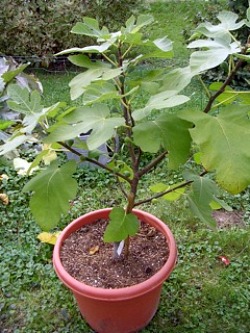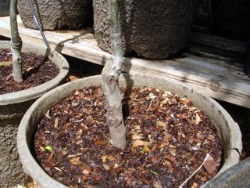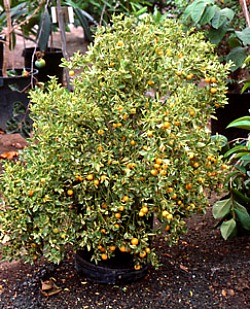How To: Overwinter Containerized Fruit Trees

Fig trees grow well in containers where they can be kept dwarf. They can be
left outdoors in mild winter climates, but need protection in any
location that gets below 20 degrees F.

When overwintering fruit trees in containers, be sure to protect the graft
union. This is where the desired variety is attached to the rootstock.
If the union fails, you'll lose the variety you wanted to grow.

Citrus trees need protection from temperatures that dip below freezing. Move them into a protected location before cold winter hits.
As more people grow edibles in their large and small yards, many are discovering the convenience and joy of growing fruits in containers.
There are newer varieties available that grow in a naturally dwarf
shape, making them easy candidates for container growing. Gardeners
with small yards can now enjoy fruit growing like everyone else. Plus,
new styles of lightweight, durable containers make growing a large tree
possible and easier to move around.
While growing figs, lemons, apples, blueberries, and other fruits in containers is easier than ever before, if you live in a cold winter
climate, you'll need to protect your plants in winter. Freezing and
thawing and winter minimum temperatures can cause even hardy fruits to
perish. So, here's a rundown on ways to protect your containerized
fruit this winter and enjoy the fruits of your labor for years to come.
Know Your Fruit Different fruit trees have different needs and aversions to cold. Citrus shouldn't be exposed to
freezing temperatures, while temperate climate fruits such as apples
can tolerate some freezing. If you live in a mild winter climate, you
may be able to leave your container fruits outdoors in winter with
minimal protection.
Reduce Watering and Fertilizing As fall approaches, gradually reduce watering and stop fertilizing to get your tree ready for the cold weather and shorter days.
Outdoor Protection of Fruits Protect fruits outdoors in mild winter climates by placing the trees in a protected
spot against a building shielded from cold north and west winds. Wrap
the tree in burlap and create a wire cylinder around the container and
tree and fill it with hay, leaves, or straw to offer more insulation.
When to Bring Indoors Citrus should be brought indoors before a first frost and when the nights dip into the 30 F’s.
Deciduous fruits, such as apples, blueberry, and fig, should be allowed
to drop their leaves outdoors, then moved indoors soon afterward in
cold climates.
Indoor Protection of Fruit Trees Place containers in an unheated, attached garage or basement where they will be exposed
to cold temperatures, but the roots and tree won't die due to severe
cold. The roots of most deciduous tree fruits are hardy to 0 degrees F,
but should be protected where ever the temperatures dip below 20F. If
your storage area may dip down even colder than 20F, consider wrapping
the tree with burlap and hay or straw as described above for added
insulation.
Soil Conditions Once brought indoors, keep the soil slightly moist. Too wet and the roots will rot. Too dry, and the roots will die for lack of water.
Moving Back Outdoors Move your fruit trees back outdoors in spring after all danger of frost has passed. Many trees,
such as figs, will start leafing out indoors in late winter based on
their internal clock. Keep the soil slightly moist and conditions cool
to slow the leaf growth until they can be moved outdoors. Once
outdoors, place the trees in a partly shaded area for a few days to get
accustomed to the higher light levels. Then move them into full sun.
Views: 6
© 2025 Created by Aggie.
Powered by
![]()